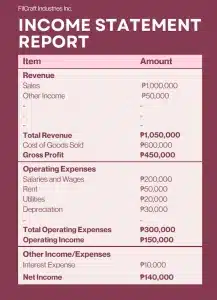Are you struggling to understand your manufacturing financial statements? Or maybe you’re stuck making strategic decisions without the right data to back you up? Kaya nandito ka sa tamang lugar, since we’re here to provide solutions.
But before we dissect everything in detail, you might have realized that you need a faster, more accurate way to generate those complex reports. But what’s the right tool to do so?
Don’t worry, you can try HashMicro’s Accounting System as one of the tools! It’s built to handle manufacturing-specific financials, easy to set up, and helps you create detailed, reliable statements without the manual hassle. Win-win!
In this article, we’re breaking down manufacturing financial statements: what they include, why they matter, and how to make sense of them. Let’s dive into everything you need to know, so you can stop guessing and start making smarter decisions for your factory.
Table of Contents

Key Takeaways
|
What are Manufacturing Financial Statements?
Manufacturing financial statements are documents prepared by companies in the factory sector to record and report their economic performance. These statements include specific information about the production of goods, including raw material costs, direct labor costs, and factory overheads.
Manufacturing income statements also record inventory in various stages, such as raw materials, work-in-progress, and finished goods. The difference between manufacturing statements and financial statements of non-manufacturing companies lies in the level of detail provided regarding production costs and overhead allocation.
These reports are critical in identifying areas that require improvement, both in terms of cost control and operational efficiency. This report is usually held by internal and external parties to gain a deeper understanding of the company’s financial health and its performance in the manufacturing industry.
Hashy AI Fact

Need to know!
Hashy AI by HashMicro auto-generates key financial reports, saving time, cutting errors, and aiding informed decisions with real-time data.
Get a Free Demo Now!
What Makes Manufacturing Financial Statements Different?
Earlier we explained that the difference between the financial statements of manufacturing companies and the financial statements of non-manufacturing companies lies in the level of detail provided regarding production costs and overhead allocation.
But are the differences limited to that? Of course not, so let’s dive deeper into the differences between manufacturing company income statements and financial statements of non-manufacturing companies so that you can better understand the differences.
The main difference between manufacturing financial statements and financial statements of non-manufacturing companies, apart from the level of detail of production costs and overhead allocation, lies in the inventory components and the types of costs recorded. In manufacturing companies, inventory consists of three categories, namely raw material, and finished goods.
As for non-manufacturing companies, such as service or trading companies, generally the financial statements made only record merchandise inventory for trading companies or have no inventory at all for service companies.
In addition, manufacturing companies record direct production costs and factory overhead costs, which include the cost of raw materials and labor used in the production process. Non-manufacturing companies, especially service companies, focus more on direct operating costs that are not related to the production of goods.
Finally, manufacturing companies also involve work-in-progress as part of the production process. This is the stage where the product is not fully completed and is still in the manufacturing stage. On the other hand, non-manufacturing companies do not have assets such as work-in-progress.
4 Key Points in Manufacturing Financial Statements
Manufacturing financial statements consist of four main components that complement each other to provide a complete picture of the company’s financial condition. These components include the Statement of Cost of Goods Manufactured, Income Statement, Balance Sheet, and Cash Flow Statement.
These four reports together help companies analyze production costs, operational performance, financial position, and cash flows that occur during a certain period. Here is the explanation:
Statement of cost of goods manufactured
This statement records all costs associated with the production process during a specific period, and is very important in manufacturing companies as it provides an in-depth breakdown of how much it costs to produce finished goods.
This report includes three main elements: raw material costs, direct labor costs, and factory overhead. Raw materials include all the raw materials used in production, while direct labor is the cost associated with the labor directly involved in making the product.
Factory overhead includes indirect costs such as machinery maintenance, electricity, rent, and depreciation of factory assets. This statement also shows the value of work-in-progress at the beginning and end of the period, helping to calculate the total production cost for goods completed during the period.
Income statement
The income statement in a manufacturing company presents the financial results for a given period, by presenting the revenue from the sale of finished goods and deducting all related costs, including production costs derived from the cost of goods manufactured report, as well as other operating expenses such as selling, administrative, and tax expenses.
This report depicts gross profit, operating profit, and finally net profit, providing a clear picture of how well the company manages its expenses in generating profits. As manufacturing companies often have complex cost structures, this report is critical to understanding the profitability of production activities and the sale of finished goods.
Below is a sample of a manufacturing income statement:

Balance sheet
A balance sheet presents the financial position of a company at a particular point in time. In the context of a manufacturing company, this balance sheet records the company’s assets, liabilities, and equity. The assets of a manufacturing company do not only consist of cash and receivables, but also include inventories of raw materials, work-in-progress, and finished goods ready for sale.
Fixed assets such as plant, machinery, and equipment are also recorded in the balance sheet. The liability side records all debts and other obligations the company has, while equity reflects the ownership of the company’s owners. This balance sheet provides an overall view of the company’s financial health, especially in terms of the assets used to support the production process.
Cash flow statement
The cash flow statement tracks the inflows and outflows of cash over a given period related to the company’s operations, investments, and financing. In manufacturing companies, this report is especially important because the production process often requires large investments in raw materials, labor, and machine maintenance.
The cash flow statement is divided into three sections: operating cash flow, which includes revenue from the sale of goods and payments for raw materials and production costs; investing cash flow, which includes expenditures for the purchase of fixed assets such as equipment and machinery; and financing cash flow, which includes activities such as loan repayments and dividend distributions.
With these financial reporting tools in manufacturing, companies can ensure that they have enough cash to support their day-to-day operations and future growth plans.
Common Mistakes When Preparing Manufacturing Income Statements
Preparation of income statement for manufacturing is not an easy thing to do. It is not uncommon for many mistakes to appear in the preparation of this report. The following below are some common mistakes that often appear in preparing an income statement for manufacturing:
Errors in operating cash flow
Recording errors in operating cash flow are also common, especially when it comes to accounting for cash that goes out to buy raw materials or pay other manufacturing costs. Incorrectly including non-operating expenses or income in operating cash flow can give a false picture of the company’s liquidity.
Miscalculation of overhead costs
One of the most common mistakes in preparing an income statement for manufacturing is an error in allocating factory overhead. Overhead costs include indirect costs such as depreciation, maintenance, and utilities, which are often difficult to calculate accurately.
If the overhead allocation is too high or too low, it will cause distortion in the calculation of Cost of Goods Manufactured and ultimately affect net profit. Errors in the allocation of factory overhead can also make the financial statements appear to not reflect actual conditions.
Not accounting for inventory properly
The next common mistake in preparing an income statement for a manufacturing business is not accounting for inventory properly. Inventory in a manufacturing company itself consists of raw materials, work-in-progress, and finished goods.
Not accounting for inventory properly will have an impact on the inaccurate calculation of the quantity or valuation of inventory prices. For example, if work-in-progress is not calculated correctly, the value of finished goods will also be affected, which then affects the calculation of cost of goods manufactured and the income statement.
Improper revenue recognition
Furthermore, errors in revenue recognition are a frequent issue, especially in manufacturing that uses long-term contracts or large projects.
Some companies may recognize revenue too early, before products are completed or shipped to customers.
Conversely, delaying revenue recognition after goods are shipped is also not a good thing to do as it can cause a problem in reflecting the company’s performance properly.
Error in recording direct labor
Direct labor costs are costs related to workers who are directly involved in the production process. Common errors occur when companies do not include all direct labor costs or misallocate them. For example, not properly recording overtime hours or employee wages can lead to an inaccurate calculation of production costs, which ultimately affects the results on the income statement.
The Importance of Manufacturing Financial Statements
Manufacturing financial statements must be accurate as these reports are used by management, investors, and other stakeholders to assess the financial health of the company and make informed business decisions. Accurate reports allow companies to know exactly their production costs, profitability, cash flow, and operational efficiency.
You definitely don’t want the mistakes we’ve mentioned above to happen to you, do you? Don’t worry, because we will present tips that you can do to make the preparation of income statement for manufacturing business accurate. Here are some tips:
Use an integrated accounting system
Using accounting or ERP for manufacturing helps monitor and record all transactions precisely, from purchasing raw materials to selling finished goods. This system facilitates accurate and automated record keeping.
One example of an accounting system that you can use is the accounting system from HashMicro. HashMicro has seamless integration capabilities with other systems, such as manufacturing software, procurement software, HR system, accounting software, and many more.
To understand how this system can have seamless integration, you can try the demo provided for free by clicking here!
Perform periodic inventory reconciliation
Inventory is a big component in manufacturing income statements. Perform regular inventory reconciliations between inventory records and physical counts in the warehouse to avoid discrepancies between reports and reality. This is especially important to ensure that the value of raw materials, work-in-progress, and finished goods are recorded correctly.
Allocate factory overhead appropriately
Ensure that factory overheads such as utility costs, machine depreciation, and maintenance costs are accurately allocated to the products produced. Use appropriate overhead allocation methods, such as allocation based on direct labor hours or machines used, to reflect the true cost of production.
Monitor production costs in real-time
By tracking production costs in real-time, companies can identify deviations or problems in production as soon as they occur. This includes recording raw materials used, labor deployed, and any changes in overhead costs.
Monitor production costs directly and continuously
By monitoring production costs directly and continuously, companies can immediately detect deviations or potential problems that arise during the production process. This allows the company to take immediate corrective action before the problem becomes bigger and has a significant impact on overall costs.
This monitoring includes real-time recording of raw materials used in each stage of production, the amount of labor deployed, as well as possible changes in overhead costs such as machine maintenance or increased utility costs. Usually it can be done with manufacturing accounting software.
Conduct regular and detailed internal audits
Regular and detailed internal audits are essential to ensure the accuracy and completeness of the company’s financial statements. By conducting regular audits, companies can identify errors in financial records, potential irregularities, and inefficiencies that may not be apparent on routine reviews.
These audits can also reveal accounting issues that may have been missed or even errors in the application of financial policies.
Preparing Manufacturing Financial Statements with HashMicro Accounting System

HashMicro’s accounting system is one that comes with a comprehensive range of features to help with various financial management needs in a business, one of which is the preparation of a manufacturing income statement.
As a vendor, HashMicro also understands that transparency in money management is important. This is why they do not limit the number of users so that the financial management process can be supervised by several people at once.
Furthermore, you don’t have to worry about scalability in HashMicro’s accounting system. The system has extensive scalability to ensure it can work optimally as your business grows.
Here are the features of HashMicro accounting system that can help you in managing manufacturing income statement:
- Bank Integration – Auto Reconciliation: Ensure that the balance recorded in the internal bookkeeping is in accordance with the balance recorded in the bank.
- Bank Integration – Auto Payment: Ensure payment transactions are scheduled and executed on time.
- Cash Flow Reports: Monitor the company’s cash inflow and outflow to ensure sufficient liquidity, make proper financial planning, and identify and address potential financial issues.
- Financial Ratio: Helps users to analyze the company’s financial health quickly and accurately, and understand financial performance more deeply to support strategic decision making.
- Financial Statement with Budget Comparison: Provides a clear picture of how the company’s actual financial performance matches the plan to identify deviations and make necessary adjustments to achieve financial goals.
Conclusion
A manufacturing income statement is an important document in a manufacturing business that contains the financial statements in the company. This document has an important role because it is used as a basis by management or external parties to determine the level of health in the company’s financial activities.
Therefore, the preparation of this document must be done properly and thoroughly. Meanwhile, one of the steps that can be taken to minimize report preparation errors is to use an accounting system, such as HashMicro. The HashMicro system is equipped with various features and a user-friendly interface. So, the implementation of this system will not be difficult and time consuming.
Make your manufacturing income statement preparation less error-prone by trying a free demo of HashMicro by clicking here!




































